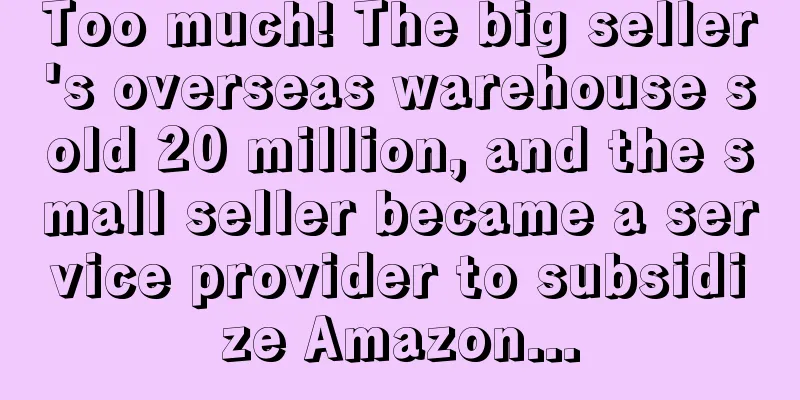|
In March, the temperature gradually rises in many parts of the country, but spring for cross-border people has not yet arrived. On the one hand, the Russia-Ukraine conflict is closely concerning people around the world. As the international situation continues to change, its impact on the global economy and e-commerce industry is increasing, and the butterfly effect is becoming more and more severe. On the other hand, cross-border e-commerce is undergoing a major test of the times. In the front, there is the compliance impact of Amazon, and in the back, there are the closures of several platforms. In addition, challenges such as logistics disruptions, severe epidemics, and exchange rate fluctuations are forcing cross-border sellers to grow rapidly. Nowadays, cross-border e-commerce is no longer synonymous with making money. As the wind of involution sweeps across the border, more and more sellers realize that it is not feasible to sell goods only on the platform. Therefore, another model has gradually emerged in the circle, that is, sellers no longer sell goods only on the platform, but carry out multiple businesses, acting as both sellers and service providers. Involving multiple fields, cross-border sellers begin to provide services Since 2020, cross-border e-commerce has entered an era of rapid growth. Fueled by the COVID-19 pandemic, sales of online e-commerce platforms have nearly doubled. This trend not only brought many sellers to the pinnacle of their lives, but also allowed the cross-border service industry to take advantage of the situation and begin to be sought after by capital. So far, many domestic service providers have obtained financing of varying amounts. In front of the army of tens of millions of sellers, doing business with sellers seems to be a good choice. Therefore, many sellers began to try to transform, including some of the industry's top sellers. They launched their own new services, involving logistics, supply chain, training, software services and other fields, trying to get a share of the service provider industry. 1. Lechuang sells some of its overseas warehouses It is learned that by the end of 2021, LEACHO has overseas warehouses in the United States, Germany, Japan and other places, with a total of 15 warehouses worldwide , and a delivered area of 260,000 square meters. In the first half of 2021, LEACHO's cross-border e-commerce public overseas warehouse innovation service complex project achieved operating income of 68.1102 million yuan, with good profitability. ▲ The picture comes from Levo announcement It is learned that recently, Lechuang announced that it has agreed to sell its subsidiary 's overseas warehouse with a building area of approximately 95,872 square feet located at 1151 Commerce Blvd., Logan Township, New Jersey (Block 2803, Lot 1.02). After negotiation between the two parties, the transaction price of this asset transaction was determined to be US$23 million. The funds obtained from the sale of the target assets will be used to lease and build larger overseas warehouses to further improve Lejia’s overseas warehousing and logistics system. It can be said with certainty that this layout fully demonstrates Leckey's foresight in cross-border expansion. At a time when the global supply chain is extremely unstable, having its own logistics channels and overseas warehouses is a huge advantage in its overseas expansion. The sale of overseas warehouses has also enabled Leckey to transform from a seller to a service provider. In addition to operating overseas warehouses, Leckey is also constantly improving its own logistics network and even plans to build container ships on its own. ▲ The picture comes from Levo announcement In January this year, Leckey announced that it plans to sign a contract with a first-class domestic shipyard to build a 1,800TEU container ship for a total construction price of US$32.6 million. The container ship to be built this time is expected to be delivered in 2023. As for the reason for building container ships, Leckey stated that by building or chartering ships, it can strengthen supply chain security, improve supply chain efficiency, reduce transportation costs, further enhance the user experience of fast delivery of e-commerce shopping, shorten delivery cycle, and increase inventory turnover. 2. Jihong shares launched SaaS service platform In addition to the big sellers on Amazon, Jihong Co., Ltd., a big seller focusing on the Southeast Asian market, has also joined the service provider track. It is learned that on January 20, the Southeast Asian cross-border e-commerce GiiMall SaaS service platform ("GiiMall") under Jihong Holdings was officially launched for public beta. It is understood that Jimiao Cloud is a full-link ecological platform focusing on cross-border e-commerce. It will provide sellers with one-stop services for the entire chain, including product selection, website building, marketing, payment, warehousing, logistics, and customer management. It aims to help domestic merchants and foreign Internet celebrities and bloggers quickly explore new paths for "going overseas" and supply chains, create a new main marketing position, and achieve "super growth" in cross-border e-commerce business. This GiiMall public beta mainly presents the following three highlights: 1. Localized small language mall templates support rapid construction of independent sites 2. In-depth intelligent advertising delivery and business data analysis for business scenarios 3. Expand platform services and build a cross-border e-commerce ecosystem Jihong shares said that this year, it will continue to publicly test the two modules of intelligent product selection and warehousing logistics, and empower more sellers with "technology + experience". The SaaS service platform will continuously improve the platform system functions through continuous research and gradual practice, and help maximize the value of brands going overseas. 3. Tongtuo launches training business At present, the cross-border e-commerce service industry has formed a relatively complete industrial chain. These service providers not only provide substantial help to sellers, but also inject vitality into the healthy development of the cross-border market. With the rapid increase in the number of novice sellers entering the cross-border industry, cross-border training services have gradually entered the public eye and are developing rapidly. As a result, many experienced and qualified sellers have also smelled this business opportunity and transformed themselves from cross-border sellers to mentors, such as the well-known Tongtuo Technology. It is understood that in 2021, Tongtuo Technology proposed a three-pronged development strategy of "talent training + project incubation + investment fund" to provide one-stop empowerment support for cross-border e-commerce sellers. In July last year, Tongtuo officially announced the establishment of the Cross-border E-Academy to create a one-stop cross-border e-commerce training and incubation base, using 17 years of accumulated cross-border experience and resources to provide practical empowerment, cultivate cross-border win-win partners, expand global markets, and help brands go overseas. It is reported that Tongtuo Cross-border E-Academy has opened seven classes so far and has made good progress. In addition, in December last year, Tongtuo also established a cross-border e-commerce equity investment fund, focusing on the investment and incubation of cross-border e-commerce team projects . It has currently contacted several vertical Amazon sellers, empowering excellent innovative and entrepreneurial teams with its ecosystem. ▲ The picture comes from Tongtuo Technology As for why it wants to expand into the cross-border service field, Tongtuo said that its ultimate goal is to help cross-border sellers grow bigger and stronger, ultimately achieve true mutual benefit and win-win results, and build a cross-border ecological platform worth hundreds of billions of yuan. In fact, it is not new for sellers to become service providers. For example, Anker's previously launched agency operation service and Jiazhilian's e-commerce marketing service have set off a wave of enthusiasm in the industry. So why do cross-border sellers all want to join the ranks of service providers? What secrets are hidden behind sellers’ competition to become service providers? It is learned that sellers working part-time as service providers has become a trend in the cross-border circle. Under the background of increasingly stringent policies on the Amazon platform, many sellers have increased their awareness of risks and started to seek other ways out. Some sellers have completely switched to become service providers, while others have sold other services while operating. In the seller communication group, many sellers said that it is currently difficult to maintain a high profit just by selling goods on the platform. If they want to be able to do it for a long time, they have to expand their business channels and make some extra money from other aspects to subsidize Amazon. An Amazon seller with three years of experience told me that he is currently an Amazon seller and also a freight forwarder. This dual identity can not only reduce shipping costs, but also make full use of his seller resources to increase revenue. Similarly, many sellers choose to engage in evaluation, training, self-media and other businesses, which not only bring convenience and resources to their account operations, but also earn extra income and reduce the financial pressure of operating Amazon. The popularity of this phenomenon is mainly due to the following reasons: 1. Amid the wave of Amazon account bans, sellers have a stronger sense of crisis In 2021, Amazon began a large-scale review of seller accounts. Tens of thousands of accounts, including small and medium-sized sellers, were sanctioned by the platform. Many sellers' companies have encountered financial crises and have had to fight for survival. It was this platform baptism that not only made sellers pay more attention to compliance operations, but also increased their sense of crisis. They realized that due to the autonomy and authority of third-party platforms, it is difficult for platform sellers to compete with them, so they must diversify risks and seek other alternative businesses. As a result, many sellers began to leave Amazon, or set up other platforms, or turned to become service providers, or run multiple businesses in parallel. 2. The dividend effect of the epidemic has weakened, and the growth rate of cross-border e-commerce has declined It is understood that the global e-commerce market continues to maintain positive growth. In 2022, global e-commerce revenue will be close to US$908 billion. By 2024, global e-commerce sales revenue is expected to exceed offline sales. On the surface, global e-commerce is still on the rise, but in fact, this market has long been undercurrent. As the COVID-19 battle line lengthens, the dividend effect brought by the epidemic is slowly weakening, the growth rate of several major e-commerce giants is declining, and many hidden worries are gradually emerging, such as the turbulent international situation, fluctuations in the Sino-US exchange rate, supply chain crisis, and inflationary pressure. The above factors have made this industry full of uncertainty, and sellers' confidence in Amazon's ability to continue to make profits has also dropped significantly. Therefore, conducting business through multiple channels has become an option for sellers to diversify risks. 3. Logistics costs are rising, and sellers’ profits are falling sharply In recent years, the severe logistics situation has become a common pain point for sellers. On the one hand, prices are constantly fluctuating, and on the other hand, supply chain channels are unstable. Coupled with the impact of Amazon's warehouse limit policy, sellers are finding it difficult to ship goods. As Lejia stated in the announcement, since 2020, the global COVID-19 pandemic has continued to spread, the efficiency of ports in overseas countries has been generally low, and the security, timeliness, reliability and economy of the supply chain have been severely challenged. As logistics costs continue to rise, sellers' profits are shrinking. Many sellers frequently lament that they always spend more than they earn on Amazon, and that the future will become even more difficult if they do not expand into other businesses. Will the emergence of new trends widen the gap between industries? It is believed that for large cross-border sellers, entering the service provider field is a wise choice. At a time when profits on cross-border platforms are declining, it is understandable that large sellers expand channels to increase operating income. As more and more sellers disrupt the service provider industry, many peers have expressed doubts, believing that this phenomenon will exacerbate the industry's internal competition, making big sellers stronger and stronger, while small sellers will be squeezed out and have nowhere to make a living. But in fact, this statement is too simplistic. Everything has two sides, and we should also look at this phenomenon dialectically. First of all, it is undeniable that this phenomenon will indeed intensify industry competition to a certain extent and widen the gap between big sellers and small sellers. If the services of big sellers can be successfully implemented, their moat in the e-commerce industry will become wider and wider. Even if the platform's performance is poor, there will be other income to support it. However, small and medium-sized sellers bet most of their resources and funds on a single seller account, which has high operating risks and large funding gaps, making it difficult for them to compete with big sellers. To a certain extent, the rise of this model will create a certain industry gap, but the impact is also limited. In other words, even if big sellers do not become service providers, the gap between them and small and medium-sized sellers will still exist. Secondly, the transformation of large sellers has brought more possibilities to the cross-border market. It not only injects vitality into the healthy development of the cross-border service industry, but the model of combining sellers and service providers also provides certain experience and samples for small and medium-sized sellers. Finally, the intensification of industry competition is not necessarily a bad thing. The era of making money through cross-border e-commerce is gone. In the long run, this phenomenon is also a purification process for cross-border e-commerce, allowing sellers to slowly settle down and accumulate strength, thus turning cross-border e-commerce into an industry with barriers.
|










